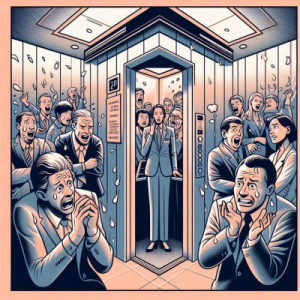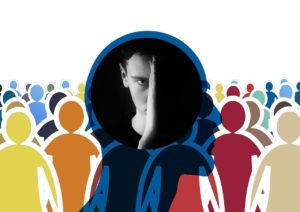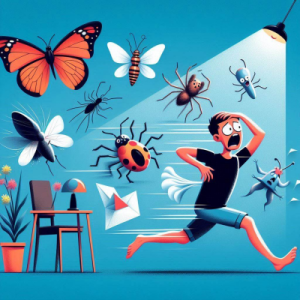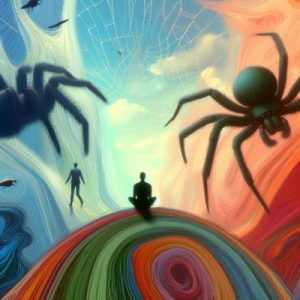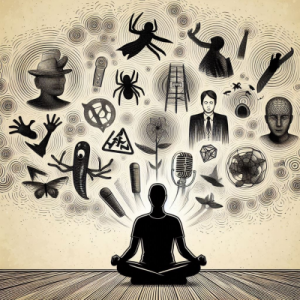Phobias can range from the seemingly mundane to the profoundly bizarre, reflecting the complex nature of human psychology. You might find it intriguing how a fear of the color yellow, known as xanthophobia, can coexist with the fear of losing your smartphone, or nomophobia. Each phobia often stems from unique experiences or cultural influences that shape our perceptions and reactions. What drives these fears, and how do they manifest in everyday life? Understanding these lesser-known phobias can provide insight into the intricacies of anxiety and its many forms.
Nomophobia
Nomophobia, affecting  around 66% of the population, is the intense fear of being without your mobile phone or losing access to its services. This phenomenon often manifests as smartphone anxiety, where you may feel an overwhelming sense of dread when your device is out of reach or the battery is running low.
around 66% of the population, is the intense fear of being without your mobile phone or losing access to its services. This phenomenon often manifests as smartphone anxiety, where you may feel an overwhelming sense of dread when your device is out of reach or the battery is running low.
Evidence shows that this anxiety can stem from a deep-seated digital dependency, where your life becomes intertwined with your phone’s capabilities, from communication to navigation.
In today’s fast-paced world, your smartphone serves as a lifeline, connecting you to friends, work, and essential information. When you’re separated from it, feelings of isolation and vulnerability can surge.
Research indicates that this reliance can lead to negative emotional and psychological effects, such as stress and decreased self-esteem.
Moreover, the constant notifications and the pressure to stay connected can exacerbate your smartphone anxiety, creating a cycle of dependence that’s hard to break.
Understanding nomophobia is important, as it highlights the significance of setting healthy boundaries with technology. By recognizing your digital dependency, you can take proactive steps to reduce smartphone anxiety and foster a healthier relationship with your mobile devices.
Triskaidekaphobia
Triskaidekaphobia, the fear of the number thirteen, affects many individuals, often manifesting in irrational anxiety around this seemingly innocuous digit.
Historically, this phobia may stem from various cultural beliefs, including the association of the number thirteen with bad luck, particularly in Western societies. You might notice that many buildings skip the thirteenth floor, reflecting a collective discomfort with the number.
Symptoms of triskaidekaphobia can range from mild unease to severe panic attacks. When confronted with the number, you might experience rapid heartbeat, sweating, or even nausea.
This reaction can extend to dates like Friday the 13th, which can trigger heightened feelings of dread.
Understanding triskaidekaphobia can help you empathize with those who experience it. It’s crucial to recognize that this fear isn’t simply a quirky trait; it’s a legitimate anxiety that can disrupt daily life.
By discussing its history and symptoms, you can foster a supportive environment for those affected, allowing them to seek help and find coping strategies.
Addressing fears, including triskaidekaphobia, is fundamental in promoting mental well-being and reducing stigma surrounding phobias.
Anatidaephobia
Anatidaephobia is a lesser-known and rather peculiar phobia characterized by the irrational fear that somewhere, a duck or goose is watching you. This phobia can trigger intense feelings of duck anxiety, making individuals hyper-aware of their surroundings, particularly in parks or near water bodies where these birds are commonly found.
You might find yourself constantly glancing over your shoulder, convinced that an innocent bird is observing your every move.
The origins of anatidaephobia can often be traced back to a combination of past experiences and broader bird-related fears. A negative encounter with a bird, or even a humorous portrayal in media, can imprint an irrational belief that these creatures are stalking you.
Such fears may be exacerbated by anxiety disorders or heightened sensitivity to the presence of animals.
Understanding this phobia is essential for those affected, as it can severely impact daily life. Effective interventions include cognitive-behavioral therapy, which helps in reframing thoughts and reducing avoidance behaviors.
If you identify with this fear, know that you’re not alone, and seeking support can lead to effective coping strategies and increased comfort in environments where ducks or geese are present.
Ephebiphobia
For many, the shift from adolescence to adulthood can be intimidating, but for those with ephebiphobia, this stage of life becomes a source of crippling anxiety. This fear of youth or young people often stems from various factors, leading to overwhelming feelings of dread.
Understanding the roots of this phobia can help address the underlying issues associated with youth anxiety and adolescence fears.
Here are four common causes of ephebiphobia:
-
Negative Experiences: Traumatic encounters with adolescents can leave lasting emotional scars.
-
Cultural Influences: Societal portrayals of young individuals as reckless or dangerous can amplify fears.
-
Developmental Anxiety: As you navigate, the pressures of maturity and independence can trigger feelings of inadequacy.
-
Social Isolation: A lack of connection to younger peers may lead to distrust and fear.
Acknowledging these factors is essential for anyone grappling with this phobia.
Atychiphobia
While the anxiety stemming from youth can manifest in various ways, another profound fear that many individuals face is atychiphobia—the intense fear of failure. This phobia can paralyze you, making it difficult to pursue goals or take risks. You might find yourself avoiding challenges, fearing that any misstep will lead to devastating consequences.
Atychiphobia often roots itself in past experiences or societal pressures, where the expectation to succeed looms large. This fear can hinder personal growth and prevent you from fully engaging in life. However, recognizing this fear is the first step toward overcoming it.
Coping strategies play a vital role in managing atychiphobia. Techniques such as cognitive-behavioral therapy can help you reframe negative thoughts and develop a healthier perspective on failure.
Mindfulness practices may also aid in grounding you, allowing you to focus on the present rather than worrying about potential outcomes.
Selenophobia
If you’ve ever felt a chill run down your spine at the sight of a full moon, you might be experiencing selenophobia—an intense fear of the moon. This unusual phobia can trigger significant lunar anxiety, leading to feelings of dread or panic. Understanding the roots of this fear is vital for managing it effectively.
Here are some common causes of selenophobia:
-
Childhood Experiences: Traumatic events related to nighttime or the moon can instill deep-seated fears.
-
Cultural Influences: Myths and stories surrounding the moon often depict it as a source of danger or evil.
-
Visual Associations: The moon’s bright, sometimes eerie glow can evoke feelings of vulnerability or exposure.
-
Psychological Factors: Pre-existing anxiety disorders may amplify moon fears, leading to heightened responses.
If you find yourself struggling with selenophobia, it’s important to seek support. Therapy, particularly cognitive-behavioral techniques, can help you reframe your thoughts and reduce your anxiety.
Understanding that you’re not alone in this can also provide comfort. Recognizing your feelings is the first step toward overcoming your fear of the moon.
Xanthophobia
Xanthophobia, the fear of the color yellow, can manifest in unexpected ways, affecting various aspects of daily life. If you experience xanthophobia, you may feel intense anxiety or panic when confronted with yellow objects, whether it’s a sunflower, a lemon, or even someone wearing yellow clothing.
Common xanthophobia symptoms include rapid heartbeat, sweating, and even nausea, which can lead to avoidance behaviors that disrupt your routine.
Understanding the root causes of this phobia can be vital for effective treatment. Many individuals develop xanthophobia due to a past traumatic event involving the color yellow, or it may stem from cultural associations or personal beliefs.
Cognitive-behavioral therapy (CBT) is often recommended as a primary xanthophobia treatment. This approach helps you reframe negative thoughts related to the color yellow and gradually face your fears in a controlled manner.
Exposure therapy can also be beneficial, allowing you to confront yellow objects in a safe environment, thereby reducing anxiety over time.
With the right support and treatment, overcoming xanthophobia is possible, enabling you to engage more fully with the vibrant world around you.
Nyctophobia
Experiencing fear can take many forms, and nyctophobia, the fear of darkness or night, is a common yet often misunderstood phobia. This condition can lead to significant nighttime anxiety, affecting sleep and overall well-being. Understanding its fear origins is vital for those grappling with it.
-
Developmental Factors: Fear of darkness often begins in childhood, as kids naturally fear the unknown.
-
Traumatic Experiences: Past traumatic events associated with darkness can trigger or exacerbate nyctophobia.
-
Cognitive Patterns: Negative thought patterns and irrational beliefs about what lurks in the dark can sustain this fear.
-
Cultural Influences: Media portrayals of darkness often reinforce fears, suggesting that danger lurks in the night.
If you find yourself struggling with nyctophobia, know that it’s important to acknowledge your feelings.
Seeking professional help can provide coping strategies and therapeutic techniques to manage anxiety.
Remember, you’re not alone in this journey, and understanding the roots of your fear is the first step toward overcoming it.
Gaining insight into your phobia can empower you to reclaim your nights and find peace in the dark.
Chionophobia
Chionophobia, the fear of snow, might seem unusual to those who enjoy winter activities, but for many, it’s a genuine source of anxiety. If you experience snow anxiety, you may find yourself overwhelmed by the thought of winter approaching. This dread can stem from various factors, including past traumatic experiences related to snow or heightened anxiety about the cold weather’s consequences, such as travel difficulties or accidents.
Understanding the psychological underpinnings of chionophobia is essential. Often, it involves a conditioned response where you associate snow with negative experiences. Cognitive distortions may also play a role, leading you to exaggerate the dangers of snow-covered environments. You might envision worst-case scenarios that never come to pass, fueling your winter dread.
Treatment options for chionophobia include cognitive-behavioral therapy (CBT), which aims to challenge and reframe your thoughts about snow. Gradual exposure to snowy environments, paired with relaxation techniques, can help lessen your fear over time.
Taphophobia
While some fears are tied to specific environments or weather conditions, others stem from deep-seated anxieties about mortality and the unknown. Taphophobia, or the intense fear of being buried alive, is one such fear that resonates with many. This grave fear often arises from historical accounts of individuals mistakenly declared dead and subsequently buried, triggering a profound burial anxiety.
Understanding the roots of taphophobia can help you address it effectively. Here are four common causes:
-
Cultural Influences: Media portrayals of being buried alive can amplify fears.
-
Personal Experiences: Witnessing death or near-death situations may trigger anxiety.
-
Psychological Factors: Conditions like claustrophobia can intertwine with taphophobia, exacerbating fears of confinement.
-
Fear of Loss of Control: The idea of being trapped without the ability to escape can be overwhelming.
Recognizing these triggers allows you to confront and manage your fears. Whether through therapy, exposure techniques, or mindfulness practices, addressing your taphophobia can lead to a more profound sense of peace regarding mortality and the unknown.
You’re not alone in this struggle; many share similar fears that can be understood and alleviated.
Conclusion
Understanding lesser-known phobias can help you empathize with others’ experiences, even if they seem irrational. You might think these fears are trivial, but they can greatly impact daily life. Acknowledging their roots in personal experiences or cultural influences reveals the complexity of human emotions. By fostering awareness, you can support those grappling with these anxieties and perhaps even reflect on your own fears, leading to a deeper understanding of how we all navigate our unique challenges.
